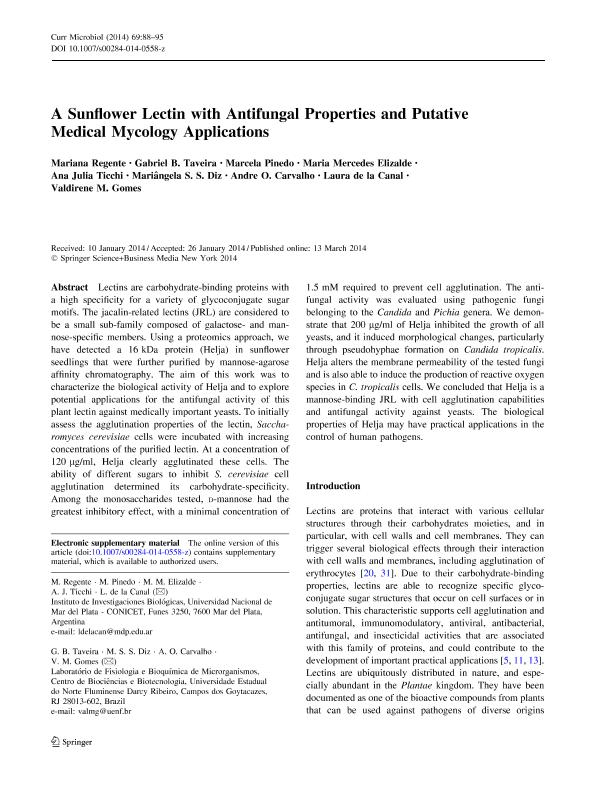Mostrar el registro sencillo del ítem
dc.contributor.author
Regente, Mariana Clelia

dc.contributor.author
Taveira, Gabriel B.
dc.contributor.author
Pinedo, Marcela
dc.contributor.author
Elizalde, Maria Mercedes

dc.contributor.author
Ticchi, Ana Julia

dc.contributor.author
Diz, Mariangela S. S.
dc.contributor.author
Carvalho, Andre O.
dc.contributor.author
de la Canal, Laura

dc.contributor.author
Gomes, Valdirene M.
dc.date.available
2018-01-23T20:28:40Z
dc.date.issued
2014-03
dc.identifier.citation
Regente, Mariana Clelia; Taveira, Gabriel B.; Pinedo, Marcela; Elizalde, Maria Mercedes; Ticchi, Ana Julia; et al.; A sunflower lectin with antifungal properties and putative medical mycology applications; Springer; Current Microbiology; 69; 1; 3-2014; 88-95
dc.identifier.issn
0343-8651
dc.identifier.uri
http://hdl.handle.net/11336/34350
dc.description.abstract
Lectins are carbohydrate-binding proteins with a high specificity for a variety of glycoconjugate sugar motifs. The jacalin-related lectins (JRL) are considered to be a small sub-family composed of galactose- and mannose-specific members. Using a proteomics approach, we have detected a 16 kDa protein (Helja) in sunflower seedlings that were further purified by mannose-agarose affinity chromatography. The aim of this work was to characterize the biological activity of Helja and to explore potential applications for the antifungal activity of this plant lectin against medically important yeasts. To initially assess the agglutination properties of the lectin, Saccharomyces cerevisiae cells were incubated with increasing concentrations of the purified lectin. At a concentration of 120 μg/ml, Helja clearly agglutinated these cells. The ability of different sugars to inhibit S. cerevisiae cell agglutination determined its carbohydrate-specificity. Among the monosaccharides tested, d-mannose had the greatest inhibitory effect, with a minimal concentration of 1.5 mM required to prevent cell agglutination. The antifungal activity was evaluated using pathogenic fungi belonging to the Candida and Pichia genera. We demonstrate that 200 μg/ml of Helja inhibited the growth of all yeasts, and it induced morphological changes, particularly through pseudohyphae formation on Candida tropicalis. Helja alters the membrane permeability of the tested fungi and is also able to induce the production of reactive oxygen species in C. tropicalis cells. We concluded that Helja is a mannose-binding JRL with cell agglutination capabilities and antifungal activity against yeasts. The biological properties of Helja may have practical applications in the control of human pathogens.
dc.format
application/pdf
dc.language.iso
eng
dc.publisher
Springer

dc.rights
info:eu-repo/semantics/openAccess
dc.rights.uri
https://creativecommons.org/licenses/by-nc-sa/2.5/ar/
dc.subject
Susnflower
dc.subject
Helja
dc.subject
Lectin
dc.subject
Mannose
dc.subject
Antifungal
dc.subject.classification
Otras Ciencias Biológicas

dc.subject.classification
Ciencias Biológicas

dc.subject.classification
CIENCIAS NATURALES Y EXACTAS

dc.title
A sunflower lectin with antifungal properties and putative medical mycology applications
dc.type
info:eu-repo/semantics/article
dc.type
info:ar-repo/semantics/artículo
dc.type
info:eu-repo/semantics/publishedVersion
dc.date.updated
2017-12-11T16:44:21Z
dc.journal.volume
69
dc.journal.number
1
dc.journal.pagination
88-95
dc.journal.pais
Alemania

dc.journal.ciudad
Berlin
dc.description.fil
Fil: Regente, Mariana Clelia. Consejo Nacional de Investigaciones Científicas y Técnicas. Centro Científico Tecnológico Conicet - Mar del Plata. Instituto de Investigaciones Biológicas. Universidad Nacional de Mar del Plata. Facultad de Ciencias Exactas y Naturales. Instituto de Investigaciones Biológicas; Argentina
dc.description.fil
Fil: Taveira, Gabriel B.. Universidade Estadual Do Norte Fluminense Darcy Ribeiro;
dc.description.fil
Fil: Pinedo, Marcela. Consejo Nacional de Investigaciones Científicas y Técnicas. Centro Científico Tecnológico Conicet - Mar del Plata. Instituto de Investigaciones Biológicas. Universidad Nacional de Mar del Plata. Facultad de Ciencias Exactas y Naturales. Instituto de Investigaciones Biológicas; Argentina
dc.description.fil
Fil: Elizalde, Maria Mercedes. Consejo Nacional de Investigaciones Científicas y Técnicas. Centro Científico Tecnológico Conicet - Mar del Plata. Instituto de Investigaciones Biológicas. Universidad Nacional de Mar del Plata. Facultad de Ciencias Exactas y Naturales. Instituto de Investigaciones Biológicas; Argentina
dc.description.fil
Fil: Ticchi, Ana Julia. Consejo Nacional de Investigaciones Científicas y Técnicas. Centro Científico Tecnológico Conicet - Mar del Plata. Instituto de Investigaciones Biológicas. Universidad Nacional de Mar del Plata. Facultad de Ciencias Exactas y Naturales. Instituto de Investigaciones Biológicas; Argentina
dc.description.fil
Fil: Diz, Mariangela S. S.. Universidade Estadual Do Norte Fluminense Darcy Ribeiro;
dc.description.fil
Fil: Carvalho, Andre O.. Universidade Estadual Do Norte Fluminense Darcy Ribeiro;
dc.description.fil
Fil: de la Canal, Laura. Consejo Nacional de Investigaciones Científicas y Técnicas. Centro Científico Tecnológico Conicet - Mar del Plata. Instituto de Investigaciones Biológicas. Universidad Nacional de Mar del Plata. Facultad de Ciencias Exactas y Naturales. Instituto de Investigaciones Biológicas; Argentina
dc.description.fil
Fil: Gomes, Valdirene M.. Universidade Estadual Do Norte Fluminense Darcy Ribeiro;
dc.journal.title
Current Microbiology

dc.relation.alternativeid
info:eu-repo/semantics/altIdentifier/doi/http://dx.doi.org/10.1007/s00284-014-0558-z
dc.relation.alternativeid
info:eu-repo/semantics/altIdentifier/url/https://link.springer.com/article/10.1007/s00284-014-0558-z
Archivos asociados
